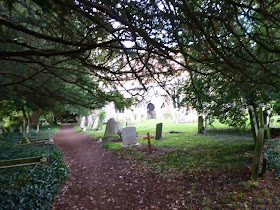 Bourn is a lovely village, a step back in time for us Americans with its narrow streets, thatched cottages, and pretty gardens. Larry and I helped ourselves to free pears offered by a generous resident as we rambled about.
Bourn is a lovely village, a step back in time for us Americans with its narrow streets, thatched cottages, and pretty gardens. Larry and I helped ourselves to free pears offered by a generous resident as we rambled about.A stone marker was yet another tie to family: the names of our two great-uncles lost in World War I were on the memorial set near the center of the village.
It was touching to find that these young men who died so long ago are still honored by their countrymen. Seeing their names and hearing Julie's description of them (one in particular she described as something of a daredevil). Julie was not certain of how these men came to their deaths, and to date no one has been to Europe to find their graves. That may be a trip in my future.
These cottages are a good example of the kind of homes we saw everywhere.
Each had a name plate tacked neatly by the door and each had a small, carefully tended garden. There was a small post office/general store in the village too, but by this time I was worrying about how many more photos I could take, and I knew we had more places to visit. So that was one photo I did not take.
I can only imagine the cost of taking care of these old buildings and the difficulty of finding people to do that kind of specialized work.
In the churchyard we found the grave of Edward Hagger, father of my grandfather.
My sister Theresa was actually the one who found this stone on a trip to England several years ago; I remember the photos Theresa took at the time, and felt a sense of...what? history? rightness? connection?...at walking in that churchyard myself, something I have dreamed of doing so many times.
To find it actually happening was stunning, almost unreal to me.
The church, Julie said, was never open when she was there. I was disappointed but content to look around the graveyard and the exterior. Then Julie grabbed and turned the ring in the door, et voila! It opened!
The bell ropes were a work of art themselves. I so wanted to pull them, but restrained myself!
Inside was again similar to the other churches; hushed, stone arches, tombs in the floor and along the walls, stained glass, beautiful wood pews, a font...I tried to imagine my great-greats sitting in those pews, heads bowed. What did they look like? Were there little children lined up beside them. squirming and being given stern looks? Were there glances between young teens, and giggles? I strained to hear the voices soaring in an ancient hymn.
The exterior of the church is in great condition; the stone masons of those long ago days knew their trade well. This church also dates to the Norman times, although it has probably been added on to a few times over the years.
It was getting late when we left, and we had the most important place of all still to visit: Caldecote, where my mother was born.
Copyright Susanna Holstein. All rights reserved. No Republication or Redistribution Allowed without attribution to Susanna Holstein.




















You obviously had a really good time on your visit and you certainly seem to have packed a lot in:) Look forward to reading about Caldecote.
ReplyDeleteI am just enthralled with all your photos and descriptions and learning your family history . . . I haven't known where to start or what to say. What a blessing for you to visit your family and the place of your Mother's birth and youth.
ReplyDelete